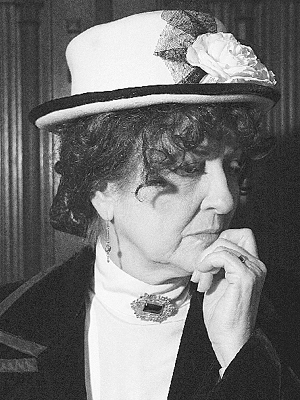By Jerry Tallmer
Ann Harson thinks Mary Ellen Quinlan O’Neill — Ella, to friends and family — got a raw deal in son Eugene’s “Long Day’s Journey Into Night,” so Mrs. Harson has written a play of her own to restore the balance.
“I wanted to vindicate her,” says Mrs. Harson, whose “Miles to Babylon,” completed some years ago on a grant from the Pennsylvania Council on the Arts, has now reached New York in a run at the American Theater of Actors through October 29.
In Eugene O’Neill’s Pulitzer Prizewinning “Long Day’s Journey” the mother, Mary Tyrone, is a hopeless morphine addict and emotional drag on all concerned — her famous actor husband, James Tyrone (i.e., James O’Neill) and their two nonfunctioning sons, Jamie and Edmund (i.e., Eugene).
In “Miles to Babylon” she is that too, a morphine addict, and has been for 25 years, but now, at a Roman Catholic convent in Ohio run by a nun who happens to be an old, unfriendly, judgmental classmate — Ella O’Neill gathers herself together and breaks the habit once and for all, cold turkey.
“Ella [as painted in “Long Day’s Journey”] was the ruination of her family,” says playwright Harson. “She deserved a little more than that. I found her interesting because we had certain things in common. Married, Catholic, with two sons. Which I adore” — as Ella O’Neill, at least in Mrs. Harson’s play, does not..
“She probably loved them, James, Jr., and Eugene, but they were atheistic and drunkards and womanizers. They both went with trollops,” says Mrs. Harson, smiling at herself for using such an old-fashioned word “because we go back to 1913 here.
“But I also wanted to demonstrate her linkage with women of the middle 1950s — women who could overcome obstacles — when Women’s Lib was in the air. Independence, all of that. And I’m an optimistic person.”
Ann Harson (“that’s my married name, not my baptized name”) was born in Brooklyn — “when, I’d rather not say” — and raised on Staten Island. She has a BA in English from Brooklyn College, an MA in English from NYU, where her mentor — ”a genius” — was Bernard Grebanier, “the one who told me I was a better writer than actress. I was too shy to be an actress. I hide behind the scenery.” But her “Waiting Star” script won her a Grebanier Playwriting Award.
Her own favorite playwrights were, in this order, Tennessee Williams, Arthur Miller, and Eugene O’Neill — “third because he wrote some bad plays.”
(Indeed “The Hairy Ape,” one of his pretty strange plays, at least to some minds (my own), is getting a revival at this very moment by the fine Irish Repertory company on West 22nd Street.)
“When I decided to write about Ella O’Neill,” says Ann. Harson, “I read everything about the O’Neills I could, including books by Arthur and Barbara Gelb and by Louis Scheaffer. I just kind of took a few facts and then let my imagination take over.”
All the characters in “Miles to Babylon,” except for Ella O’Neill herself, are fictitious — the Mother Dolores in charge of the likewise fictitious Convent and School of the Sacred Cross, two young nuns who have sympathy for Ella, and Archie, a dimwitted handy man whom Ella tries to seduce (!!!) in her attempt to put her hands on another shot of morphine. And that mortifying contretemps sets Ella, at last, on the straight and narrow.
In the play, Ella has come to the convent to throw herself and her despair into the sheltering arms of her girlhood mentor, a Mother Elizabeth – only to find, on arrival at the convent, that Mother Elizabeth is dead, with Mother Dolores now ruling the coop.
A thoughtful article on “Mrs. O’Neill’s Illness” by Eugene O’Neill biographer Stephen A. Black informs us (as it did playwright Harson) that there was indeed a real Mother Elizabeth in young Ella Quinlan’s life — a Mother Elizabeth who provided reassurances that Ella could not get at home, and encouraged the girl to work toward becoming a concert pianist. (Instead, Ella married James O’Neill.)
There is also reason to believe that Ella O’Neill’s final complete break with the morphine habit after 25 years took place at a convent, not in Ohio, but Brooklyn. “I looked for anything in Brooklyn, and could not locate it, so in the play I just let Ella go back to a convent in the Midwest. I thought it more interesting.”
Were you ever in a convent yourself, Mrs. Harson?
“No, no. Me? No, far from it. But I did research. I did go so far as to visit a convent in Pennsylvania, and I also went to a drug facility where I found out you could withdraw from morphine in 72 hours.”
The playwright’s husband is Robert Harson, a retired Lehigh University professor of English. Their sons are Neville, a therapist in Boulder, Colorado, and Court, a senior producer on MSNBC’s “Hardball.” Robert and Ann Harson live on this city’s Upper West Side, a few minutes walk from her day job hosting authors’ events at the Barnes & Nobel at 82nd Street and Broadway.
“Miles to Babylon” has had readings over the years with Geraldine Fitzgerald, Kathleen Chalfant, and Maria Tucci as Ella. The Ella of the production that’s now here, thanks to Sheila Moran of Evensong Associates, is Karen Gibson. Angela Della Ventura is Mother Dolores, James Nugent is the Archie, Nina Camp and Rachel Schwartz are the two younger nuns. The director is Tom Thornton.
“Not much has changed in the play,” says the woman who wrote it. “I write pretty slowly. But carefully.”
Ella O’Neill, rest easy. What’s that screwed-up kid Eugene know anyway?
MILES TO BABYLON. By Ann Harson. Directed by Tom Thornton. An Evensong Associates production through October 29 at the American Theater of Actors, 314 West 54th Street, (212) 868-4444.





































